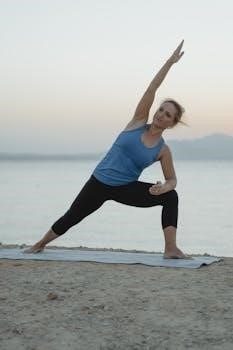
Torticollis Exercises PDF⁚ A Comprehensive Guide
This comprehensive guide offers valuable information about torticollis,
a condition affecting neck muscles, often seen in infants. Inside, you’ll
find insights into understanding torticollis, recognizing its signs early,
and the importance of prompt intervention, setting the stage for effective
management.
Understanding Torticollis
Torticollis, often referred to as “wry neck,” is a condition characterized
by the tightening or shortening of the sternocleidomastoid (SCM) muscle,
which runs along the side of the neck. This muscle’s primary function is
to control head movement, including rotation and side flexion. When
torticollis occurs, it causes the head to tilt to one side while the chin
rotates to the opposite side.
In infants, the most common form is congenital muscular torticollis (CMT),
present from birth or shortly thereafter. CMT may arise due to the baby’s
position in the womb, potentially leading to muscle compression or
restricted blood flow.
Acquired torticollis, though less frequent in infants, can result from
various factors, including injury, inflammation, or even certain
medications. Understanding the underlying cause of torticollis is crucial
for determining the appropriate course of treatment. Early identification
and intervention are key to preventing long-term complications and
restoring normal neck movement and posture. This guide provides valuable
information to help parents and caregivers recognize and address this
condition effectively.
Identifying Torticollis in Infants
Recognizing torticollis in infants is crucial for early intervention. Key
signs include a noticeable head tilt to one side, often accompanied by the
chin rotating towards the opposite shoulder. Parents may observe that their
baby prefers looking in one direction and resists turning their head the
other way.
Another common indicator is a limited range of motion in the neck. The
infant may struggle to turn their head fully to both sides. A soft lump or
knot may be felt on the affected side of the neck, within the
sternocleidomastoid muscle.
Facial asymmetry can sometimes develop, with one side of the face appearing
slightly flatter than the other, especially if the condition is left
untreated for an extended period. Plagiocephaly, or flattening of the head
on one side, may also occur due to the infant consistently resting their
head in the same position.
During tummy time, the baby might have difficulty lifting their head or
preferentially turn it to one side. If you notice any of these signs, it’s
essential to consult with a pediatrician or physical therapist for a proper
diagnosis and guidance on appropriate exercises and interventions;

Importance of Early Intervention
Early intervention for torticollis is paramount to ensure optimal outcomes
for infants. Addressing torticollis promptly can prevent the condition from
worsening and mitigate potential long-term complications. When identified
early, torticollis is often highly responsive to conservative treatment
approaches, such as stretching exercises and positional techniques.
Early intervention can help prevent the development of secondary issues like
plagiocephaly (flat head syndrome) and facial asymmetry, which can arise
from prolonged preferential head positioning. Addressing the muscle
tightness early on can help restore a full range of motion in the neck,
allowing the infant to explore their environment more freely and develop
motor skills symmetrically.
Furthermore, early treatment can minimize the need for more invasive
interventions later in life. Consistent stretching and positioning
exercises, guided by a physical therapist, can effectively lengthen the
shortened neck muscles and improve head control.
By intervening early, parents can also help prevent developmental delays
that might occur if the infant’s ability to interact with their surroundings
is limited by the torticollis. Early intervention empowers parents with the
knowledge and tools to actively participate in their child’s care, leading
to better outcomes and improved quality of life.

Stretching Exercises for Torticollis
This section provides a detailed overview of effective stretching exercises
designed to alleviate muscle tightness associated with torticollis. These
exercises, when performed consistently and correctly, can significantly
improve neck mobility and promote balanced muscle development in infants.
Rotation Stretches
Rotation stretches are crucial for improving your child’s ability to turn
their head from side to side, addressing the limited range of motion often
experienced with torticollis. These stretches gently encourage the neck
muscles to lengthen and relax, helping to correct head tilt and improve
overall neck flexibility. It’s essential to perform these stretches slowly
and carefully, paying close attention to your child’s cues and avoiding any
force or discomfort.
To perform rotation stretches, lay your child on their back on a comfortable
surface like a changing table or play mat. Gently cradle their head with
one hand, and place the other hand on their shoulder to stabilize it. Slowly
turn your child’s head towards the affected side, holding the stretch for a
few seconds. Repeat this movement several times, gradually increasing the
range of motion as your child becomes more comfortable.
Remember to maintain a calm and reassuring demeanor throughout the
stretching session. Engaging your child with gentle talk or singing can help
them relax and cooperate. Consistency is key, so aim to incorporate these
rotation stretches into your daily routine, performing them several times a
day to achieve optimal results.
Side Flexion Stretches
Side flexion stretches are vital in addressing the tightness in the neck
muscles that causes the head to tilt to one side, a hallmark of torticollis.
These stretches gently encourage the muscles on the shortened side of the
neck to lengthen, promoting a more balanced and aligned posture. It is
crucial to perform these stretches with utmost care, observing your child’s
reactions and stopping immediately if they exhibit any signs of discomfort
or pain.
To execute side flexion stretches effectively, position your child on their
back on a secure and comfortable surface, such as a changing table or a play
mat. Gently cradle their head with one hand, while using the other hand to
stabilize their shoulder on the same side as the head tilt. Slowly and
carefully tilt your child’s head towards the opposite shoulder, holding the
stretch for a few seconds.
Repeat this exercise multiple times, gradually increasing the range of motion
as your child becomes more accustomed to the stretch. Maintaining a soothing
and comforting environment during these stretches can help your child relax
and cooperate more readily. Consistency is paramount, so strive to integrate
these side flexion stretches into your daily regimen, performing them
several times a day to maximize their effectiveness.
Sternocleidomastoid (SCM) Stretch

The sternocleidomastoid (SCM) muscle is a major player in torticollis, often
being the primary source of tightness that restricts head movement;
Therefore, targeting this muscle with specific stretches is crucial for
releasing tension and restoring flexibility. The SCM stretch aims to gently
elongate this muscle, encouraging it to relax and allowing for a greater
range of motion in the neck.
Begin by positioning your child comfortably on their back, ensuring their
shoulders are stable and supported. Gently tilt their head slightly back,
then rotate it so their chin points towards the opposite shoulder of the
affected SCM muscle. For instance, if your child has right torticollis, you
would rotate their chin towards their left shoulder.
Next, gently tilt their head towards the shoulder on the same side as the
torticollis. You should feel a gentle stretch along the SCM muscle on the
opposite side of the neck. Hold this position for a few seconds, maintaining
a gentle and controlled stretch. Repeat this exercise several times a day,
being mindful of your child’s comfort level and avoiding any forceful
movements.

Positional Techniques and Activities
Positional techniques and activities play a crucial role in managing
torticollis. These methods involve strategically positioning the baby
throughout the day to encourage neck movement and reduce muscle tightness.
Consistent use promotes improved flexibility.
Tummy Time
Tummy time is an essential activity for infants with torticollis,
promoting neck strength and flexibility. Regularly placing your baby on
their stomach encourages them to lift their head, which helps stretch
tightened neck muscles and build strength on the weaker side.
To make tummy time more engaging, position toys or yourself in front of
your baby to encourage them to look in different directions. This active
head movement is crucial for improving the range of motion and reducing
the head tilt associated with torticollis. Start with short sessions and
gradually increase the duration as your baby gets stronger and more
comfortable.
If your baby resists tummy time initially, try rolling up a small towel and
placing it under their chest for added support. This can make it easier for
them to lift their head and neck; Remember to supervise your baby closely
during tummy time and provide plenty of encouragement. Consistency is key,
so aim for several short sessions throughout the day to maximize the
benefits.
Tummy time not only addresses torticollis but also contributes to overall
motor development, helping your baby develop the strength and coordination
needed for crawling and other milestones. By incorporating tummy time into
your baby’s daily routine, you are actively supporting their physical
development and helping them overcome the challenges posed by torticollis.
Carrying Positions
Selecting appropriate carrying positions is crucial for infants with
torticollis, as it can significantly influence neck muscle development and
head posture. Certain holds can encourage the baby to turn their head in
the direction opposite to their preferred side, helping to stretch the
tightened muscles.
One effective technique is the “football hold,” where the baby is held
along your forearm with their head supported in your hand. Position the baby
so that they are looking away from the side they typically favor. This
encourages active head turning and helps to lengthen the shortened muscles.
Another beneficial position involves carrying the baby upright, ensuring
their head is gently turned towards the non-preferred side.
Varying carrying positions throughout the day is also recommended to promote
balanced muscle development. When using a carrier, adjust the straps to
ensure the baby’s head is aligned with their body and not constantly tilted
to one side. Avoid positions that consistently reinforce the head tilt, as
this can hinder progress.
Remember to be mindful of your baby’s comfort and adjust the position if
they seem distressed. Consulting with a physical therapist can provide
personalized guidance on the most suitable carrying positions for your
baby’s specific needs. By consciously choosing and alternating carrying
techniques, you can actively contribute to their torticollis treatment and
overall well-being.